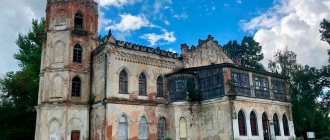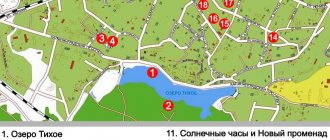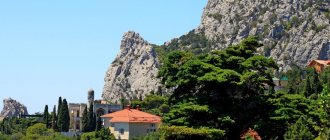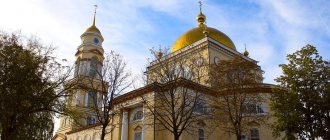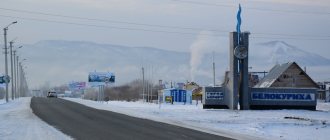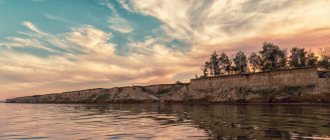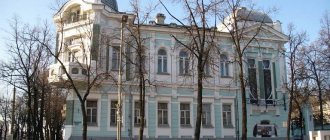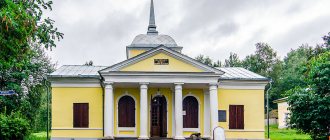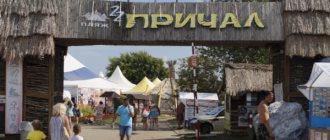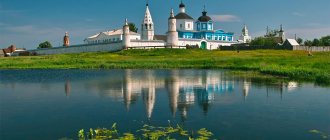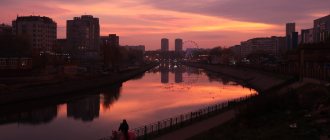Shavlinskie lakes
Shavlinsky lakes are one of the most beautiful natural attractions of Altai. a string of several Altai reservoirs stretches for 10 km in the Shavla River basin near the North Chuysky ridge. The state-protected territory is famous throughout the world for its amazing beauty. The lakes, surrounded by snow-white glaciers and mountains overgrown with forests, attract artists, photographers and tourists with the amazing purity of the water in amazing colors, which reflects the snow-covered mountain peaks - Fairy Tale, Beauty and Dream. Famous Russian travelers, comparing the nature of this region with the alpine landscape, give preference to Altai.
Each body of water has its own name. The Upper Lake, with its sloping shores consisting of huge boulders, is located at an altitude of more than 2 thousand m. The western shores of the most beautiful Lower Lake, located 5 km from the Upper Lake, are steep and rocky. On the eastern side the reservoir is surrounded by deciduous forest. This place is convenient for tourists.
Interesting places in the Altai Territory
Now let’s imagine attractions of both natural and urban origin that appeal to all travelers.
Pine ribbon pine forests
Inhaling the natural essential oils of centuries-old coniferous trees, as well as walking through a forest of tall slender pines, is an unforgettable feeling of unity with nature. For you, forest belts up to 40 km wide and up to 400 km long. The most fascinating one is located on the highway of the same name “Lentochny Bor”, but you can also get there by public transport; buses run on routes No. 55, 108, 2, 109.
Belokurikha resort town
This settlement was literally taken over by sanatoriums and health resorts. Here everything has healing properties - air with air ions and phytoncides, as well as warm radon springs. Additionally, you can go skiing here.
Mount Tserkovka
The rock has the shape of a dome on an Orthodox church, and on its top there is a four-pointed cross - hence the name.
National Museum named after A.V. Anokhina
The oldest cultural landmark of the Altai Republic, which recently celebrated its centenary, bears the name of its founder - an ethnographer, researcher of the traditions and culture of the South Siberian peoples. The collection began when the Altai Zemstvo Administration acquired a collection of exhibits, scientific books and archives from the famous Siberian scientists the Gulyaev brothers. After several moves, the museum finally settled in Gorno-Altaisk.
The exhibition covers historical periods from archaic times to the present day. It includes household items, photographs, historical documents, ancient books and manuscripts, artistic and decorative works, collections of minerals, flora and fauna.
The modern multi-tiered complex, which contains the famous sarcophagus of the “Altai princess”, is designed in the style of a mound.
3. Belukha
Belukha, crowning the Katunsky ridge, is the highest peak of the Altai mountain range. Situated on the border between Russia and Kazakhstan, the three-headed mountain was named for the color of its snow-capped peaks and one and a half hundred glacier-covered slopes. The Katun River originates there. Two peaks more than 4.5 km high - Western and Eastern - are irregular pyramids. Between them, at an altitude of 4 thousand m, is the Belukha Saddle, and on the edges are the peaks of Delaunay and Crown of Altai. Lovers of exotic nature admire one of the highest waterfalls in the region on the way to Lake Akkem with clear water and the reflection of a mountain peak in it. Since 2000, the territory received the status of a National Park.
The slopes of Belukha are popular among climbers and tourists seeking to get acquainted with the nature, history and culture of this place. Mystics consider the mountain sacred. Buddhist beliefs claim that the legendary Shambhala is located here, from where the great Buddha went to India. Local residents believed that the ice caves were inhabited by ferocious spirits that were dangerous to people. Fans of esotericism often triple their meditation on the shamanic stone.
Historical tourist places of the Altai Territory
The history of Altai goes back many millennia, so many cultural monuments remain. They are witnesses of a particular era.
Pazyryk mounds
There are excavations in the Ulagansky district near the village of Balyktuyul. The complex includes a large number of burial objects and an irrigation system. The era in which representatives of this culture lived here is the fifth century BC. You can learn about the amazing discoveries made while working on the ground in the nearby museum.
Altai Stonehenge
Stone pillars, standing firmly in the ground and having petroglyphs carved on them as decorations, are located between two mountain peaks - Sailyugem and the South Chuysky ridge. The six-meter stones, according to scientists, are the burial place of shamans. And according to popular beliefs, being here can provide emotional and spiritual cleansing.
Rock Bichiktu-Kaya
At this place there was previously a defensive structure, an outpost; at the moment, only a bomb remains in the form of a steep stone plumb with engraved hieroglyphs. Translated, the name means “written stones.” There is still debate about who owns the fortification, but the first drawings date back to the Bronze Age. The historical monument is located a few kilometers from the village of Inya.
Altai Nature Reserve
The Altai State Nature Reserve, created in 1932 to protect the flora and fauna of the taiga and high-mountain tundra, is located at an altitude of 2.5-3 thousand m near the center of Asia, in the southeast of the Altai Mountains. It is especially protected and included in the UNESCO World Heritage List.
The most important task of this Altai attraction is the preservation of the original Lake Teletskoye with amazing waterfalls, the surrounding coniferous forests and their inhabitants, who are in danger of extinction. The territory of 230 km is covered with dense forests, alpine meadows, fast-moving rivers, streams and springs with icy clear water. The biological diversity of the reserve is amazing; many representatives of flora and fauna are included in the Red Book of the Russian Federation: reindeer, snow leopard, musk deer.
Forests and reserves of Altai
Pine ribbon pine forests
Pine ribbon forest
There are five forest areas in the Altai Territory. All of them stretch along rivers and differ in width (from 5 to 40 kilometers). The largest massif is the Barnaul pine forest, located along the Ob River. Its length is more than 400 kilometers. The most amazing thing is that pine forests have no analogues, so except here you will not see such beauty and grandeur anywhere else. These places date back to the Ice Age, so the flora and fauna are not only unique, but also very diverse. Despite the high demand for tourism to these places, you may never meet anyone. This is due to the vast areas of forest, which shelter both tourists and everything else.
Tigireksky reserve
Tigireksky Nature Reserve
The area received the status of a nature reserve quite recently. Only at the end of the 20th century did the authorities manage to protect the zone from the invasion of poachers and other lovers of plundering nature. Nearby is the city of Zmeinogorsk. The main attraction is the relief. Here you can see picturesque forests, majestic mountains, mysterious cave complexes and the unforgettable beauty of the valleys of the Ini and Belaya rivers. The Tigirek fortress is an architectural monument dating back to the 18th century, which is also part of the reserve. Some species of animals and plants are considered endangered.
Arboretum "Kholmogorye"
If you are tired of the city bustle, dust and noise, then you definitely need to be in this place. Here you can take a break from everything, relieve stress and feel the full power of coniferous plants and medicinal herbs. Numerous flower beds and alpine slides with beautiful flower beds will please the eye. The total area of the complex is 800 hectares. There are leisure facilities located on it:
- Shop with organic products
- Small cafe
- Tea House
- Attractions for children
- Zoo
The arboretum is decorated with numerous plant plantations, including two reflecting ponds. Be sure to visit Kholmogorye if you like to take photos of unkempt nature.
Lake Teletskoye
The reservoir, popular among Russian and foreign tourists, is located in the northeastern part of the Altai Mountains on the border of the Western Sayan Mountains. It is included in the UNESCO World Cultural and Natural Heritage List. The lake is considered one of the iconic places in Altai. The object received its name 400 years ago from Russian travelers who met local residents from the Turkic Teles tribes on the coast of the reservoir. The indigenous inhabitants called it Altyn-Kul (Golden Lake), the inhabitants of Mongolia say: Altyn-Nuur, the Chinese are familiar with it under the name Artai.
The name is associated with the legend of a thrifty Altai man who hid a gold nugget the size of a horse's head for a rainy day. In a hungry year, he tried to exchange this value for food for his family, and when that didn’t work, he threw a piece of gold from a high mountain into the lake and jumped there himself.
For many residents of Asia, Lake Teletskoye is a shrine. The main attraction of the reservoir is the Korbu waterfall, popular among travelers, with an equipped observation deck and the largest cascading waterfall, Uchar, 160 m high. Nowadays, adventure and eco-tourism is gaining popularity in the region.
Yarovoe
A small resort town located in the Kulunda steppe zone, 450 km from Barnaul. The main attraction is the large salt lake. The beneficial properties of water and silt mud are used to treat skin diseases, diseases of the musculoskeletal system, nervous system, etc.
There is also a lot of entertainment here: a large water park, an open-air theater where various holidays and parties for young people are held.
Vacationers are also offered to fly by plane and hot air balloon, go on excursions to the Kulundinskoye and Maloe Yarovoye lakes and the natural reservoir “Teply Klyuch”.
Kamyshlinsky waterfall
A natural object - a 12-meter cascading Kamyshlinsky waterfall is located on the left bank of the Katun River, near the mouth of its tributary Kamyshly. The picturesque landscape attracts a lot of tourists who enjoy admiring the splashes crashing on the rocks and shimmering in the rays of the sun. One of the two makes a spectacular impression - the main rocky cascade. In winter, the waterfall freezes and the drops become ice crystals.
The legend explains the origin of the waterfall as a romantic love story between the beautiful daughter of the leader of the La tribe and the hero Kamysh, who protected her from prying eyes. The father who found them together ordered the faithful warrior to be thrown off the cliff, and the girl herself jumped after him. The leader, who died of grief, was buried on the top of the mountain, and the waterfall that soon appeared was named Kamysh-La in honor of the lovers. There are other versions of the origin of the reservoir.
7. Chike-Taman
The height of the mountain pass, a republican natural monument, is 1295 m. Chike-Taman stretches for 11 km, starting at 655 km of the famous Chuysky tract. Until the turn of the 19th and 20th centuries, the pass was crossed along an unsafe horse-drawn road with many risky turns. In 1903, a narrow crushed stone highway with 24 turns, which served for 80 years, was planned by the engineer and writer V. Shishkov, who wrote the famous novel “The Gloomy River”.
During archaeological excavations, the remains of an ancient road dating back a thousand years were discovered, which is now visible from the observation deck at the top. The name of the pass translated from South Altai means “straight sole”.
The road carved into granite meanders along the northeastern foothills of the Terektinsky ridge between sheer cliffs and deep gorges. Tourists observe magnificent mountain landscapes: deciduous and cedar forests, overgrown with bushes and herbs. Caves and gaps in the area of the bridge attract fans of extreme tourism and speleologists.
What to see in Altai in winter
There is a lot that can be seen in the Altai Mountains in winter - natural attractions, beautiful places of nature, thanks to which it has become popular among tourists. The large area of the territory on which they are located is more convenient for traveling by car. You can go in your own car or take a guided tour by car.
Turquoise Katun Photo: © Elena Antyufeeva
Let's highlight the most impressive places that you can visit on your own. Most lie at the entrance to the Altai Republic along the Katun River and the Chuysky and then the Chemalsky tracts. Even along the way, the landscapes will delight you with their splendor and uniqueness - the feeling that you are really in Altai.
Blue Lakes
Blue eyes of the Katun - this is the poetic name for the lakes in the area of the village of Askat on the left bank of the Katun. Small, but deep and clean reservoirs are formed by the Katun, they depend entirely on its level. Lakes appear in autumn and winter, when there is less water in the river. On a clear day, their turquoise waters, surrounded by snow-covered forest, are at their brightest and therefore most spectacular. They do not freeze: they are fed from the bottom by springs whose temperature is slightly higher than the cold air.
Read more: Blue Lakes of Katun
Blue lakes of Katun Photo: © Galina Eremina
Chemal and Patmos Island
Chemal is a large tourist village in the Altai Mountains. Due to its location, it has a comfortable climate; in winter it is one of the warmest places in Altai. Along the Katun River, near the village there is the island of Patmos . It is difficult to doubt its picturesqueness: high cliffs are crowned by a forest and a small temple of St. John the Theologian - a monastery of the Znamensky convent from Barnaul. On the left, on one of the rocks of the island, an image of the Virgin Mary is carved. The bridge leading to them, hanging high above the river, is also impressive. Hundreds of tourists come to admire the impressive landscape and touch the shrines at any time of the year.
Nearby is another attraction of the village - the Chemal hydroelectric power station . It is small, does not work today, but amazes with the noise of the Chemal River running to Katun. In winter, the water creates strange ice growths, although underneath they are still frisky. A goat path along the Katun leads to the hydroelectric power station in a southern direction from Chemal.
Chemalskaya HPP Photo: © Sergey Dal
Swan Lake
Lake Swan is a winter attraction in the Sovetsky district of the Altai Territory. Thanks to the springs, the reservoir on the Koksha River does not freeze, and several hundred swans flock to it for the winter. The inhabitants belong to the whooper species, which, unlike the mute mute, is distinguished by a straight neck.
Many tourists come to see the noble birds. The Swan reserve created here, which also includes the territory along the Katun, allows them to be protected. The swans are fed with grain, and a special observation deck is maintained for tourists, which allows them not to disturb the birds with their presence.
Read more: Lake Svetloe (Swan)
Swan Lake Photo: © Elena Antyufeeva
Kamyshlinsky waterfall
The Kamyshlinsky waterfall is formed by the Kamyshla River, which is the left tributary of the Katun. In winter, the waterfall creates a bizarre shell of ice, under which water streams run. It consists of two cascades with a total height of 12 meters. The path to the attraction is an easy walk, starting on the bridge near the Tsarskaya Okhota hotel and passing through the forest along the left bank of the Katun. Both children and older people can go to the waterfall. The one-way route is 2 km. There is a fee to cross the bridge.
Read more: Kamyshlinsky waterfall
Kamyshlinsky waterfall Photo: © Valera Danilov
Lake Teletskoye
Lake Teletskoye is a large reservoir in the northeastern part of the Altai Mountains, one of the deepest in Russia. The lake has the shape of a horizontally reflected letter “L” and occupies a narrow mountain cleft with a length of almost 80 km. The shores and surroundings of Teletskoye are replete with beautiful landscapes, and winter is no exception. Interestingly, there is no shortage of snow here, and the reservoir does not freeze completely; its southern part remains open. If clear ice occurs, it becomes a real attraction.
Tourists come to the north of Lake Teletskoye - to the tourist centers in the villages of Artybash and Yogach, ride snowmobiles, husks, horseback riding in the winter taiga, and ski down the slopes of the Teletsky GC. A silver spring , an observation deck at the top of Tilan-Tuu , low icy waterfalls of the Third River , as well as small museums of Artybash and the zoo of the Edelweiss base are accessible independently within the boundaries of the village . In addition, with an excursion you can go to the protected village of Yailyu to admire the panorama of the middle part of the lake and visit the route of the Altai Biosphere Reserve .
Read more: Lake Teletskoye
Lake Teletskoye Photo: © Galina Gorshenina
Geyser Lake
Another lake in the Altai Mountains that attracts with its amazing beauty is Geysernoye. The reservoir, measuring no more than 30 m, features many shades of blue. They owe their origin to bottom sediments created by the springs. The springs feed the lake and bring various minerals to the surface. They do not allow the lake to freeze even in severe frosts. Thanks to their activities, the spring received an unusual appearance and a sonorous name.
The attraction, ideal for impressive photos, lies not far from the Chuysky tract, but closer to its end - in the area of the village of Aktash. To get there, you need to travel almost the entire Republic. The distance from Gorno-Altaisk is 360 km. There is a boardwalk leading to the lake from the road, and there is an entrance fee.
Read more: Geyser Lake
Geyser Lake Photo: © Sergey Dal
damn finger
The Devil's Finger is a rock, part of a rock mass, a treeless mountain range lying on the left bank of the Katun River opposite the village of Souzga. The rock got its name for its resemblance to a finger and the presence of a claw on it; legend also played a certain role. Climbing the ridge is a good opportunity to admire the wide panorama of snow-capped mountains, at the foot of which the Katun runs.
Tourists have different opinions about the difficulty of the route. It is long, steep, but generally accessible to all physically active people. The path to the rock starts from Lake Aya and runs along the crest of the ridge running along the river. You need to be careful on the rocks and not try to climb on your “finger”; in winter it is easy to slip on them.
Read more: Devil's Finger Mountain
Tavdinsky caves
A network of a dozen caves occupying the Tavdinsky karst massif is the Tavdinsky (Taldinsky) caves. This is also a landmark of the left bank of the Katun; the entrances to the caves can be seen from the river. Several of the more accessible ones are incredibly popular and draw crowds of tourists in the summer. In winter, the caves are also open, but you should pay attention to having non-slip shoes and comfortable clothing.
Inside the caves there are quaint halls and narrow, low passages that you have to bend down to overcome. The tourist route is equipped with wooden stairs and lighting, but not everywhere. You need to climb a goat path to the observation deck at the top of one of the rocks. For this reason, visiting here with children under 5–7 years old is not recommended, although it is possible. Opposite the caves on the bank of the Katun there is a monument to N.K. Roerich - an artist, writer and researcher who devoted part of his life to the study of Altai culture and its secrets.
Read more: Tavdinsky caves
Tavdinsky caves Photo: © Galina Eremina
Merger of Chuya and Katun
The confluence of the Chuya and Katun is located near the village of Inya, on the 713th km of the Chuya tract. Visiting it is easy and even convenient if you are heading to the southern part of the Altai Republic. The confluence of two large Altai rivers is incredibly picturesque: at the foot of mountains dotted with depressions, the Katun runs, forming a loop. The landscape is especially beautiful in autumn, when blue rivers of different shades merge into one, contrasted with golden larches and dark mountains. But even in winter it is expressive and recognizable. In severe frosts, the rivers are almost completely covered with ice, the monochrome picture is diluted only by a narrow blue ribbon of the running Katun.
Read more: merger of Chuya and Katun
Confluence of Chuya and Katun Photo: © Alexander Reshetnikov
Museums and other cultural attractions
Local museums reflect the richness of nature and culture of the peoples of Altai. They will allow you to become more familiar with the heritage and atmosphere of the region, learn about traditions and beliefs. On the territory of Altai there are both large regional museums and small exhibitions made by enthusiasts. Let's pay attention to those that have already earned the recognition of guests.
First of all, let's note the Biysk Museum of Local Lore , because if you are traveling by car, the path will probably pass through this city. The museum is named after V.V. Bianchi, a writer who created stories about nature for children. For some time he worked in Biysk. The museum's exhibitions reveal the history of the region from different sides. One of them is dedicated to the history of the Chuya tract, another to the nature of Altai, the third to the time of the Scythians, others to Biysk for serfs and merchants, local history and culture of the 20th century. On the way from Biysk there will be the Vasily Shukshin Museum in Srostki .
Exposition in the Biysk Museum of Local Lore Photo: © Official website of the Biysk Museum named after. V. V. Bianki
You cannot ignore the National Museum named after A.V. Anokhin in Gorno-Altaisk. The modern building and rich museum collections impress every visitor. Its appearance is associated with the name of the study of Altai by N. S. Gulyaev, the artist G. I. Choros-Gurkin, and subsequently its first head A. V. Anokhin. The exhibitions also reveal different aspects of Altai history and culture, but the main value of the museum is the mausoleum with the “Altai Princess” - the mummy of a girl who lived thousands of years ago. Please note that you can only see her a few times a month. A burial model is always available.
Sights of Altai
Model of the burial in the National Museum named after A.V. Anokhin Photo: © Yulia Kopych
Those who come to Belokurikha on vacation are invited to “Andreevskaya Sloboda” - an architectural complex that represents merchant life: a manor house, a forge, a healer’s house and other outbuildings. The museum will share the secrets of baking real bread and making bread wine, tell you about the rituals that were held in barns, and let you try yourself as a blacksmith. The Anna Biletskaya Museum of Blacksmithing will try on the same role . The Belokurikha City Museum will introduce you to the history of the development of the resort and the properties of medicinal water .
Interest in folk culture has been maintained for 15 years by the “Desyatiruchka” complex in the village of Cheposh, Chemal region. It will tell you about rag dolls-amulets, printed gingerbread cookies and will introduce you to the mysteries of religious holidays. In winter, Christmas games and fortune-telling are always held here, and on Maslenitsa there are festivities with games, round dances and good-natured fun. Guests are directly involved in each program, but visits must be agreed upon.
Dolls in the “Ten Hands” complex Photo: © vad20940517
Oroktoy Bridge
One of the most stunning architectural sights of Altai is a suspended automobile structure over the Katun River in its narrowest and deepest (70 m) place. The river bottom of the depression is covered with rapids. The length of the 3-meter wide bridge is 95 m. It was erected to replace a wooden structure that was demolished by a flood in 1990. For several years, residents of the village of Oroktoy had to cross to the other side in a suspended cradle.
The bridge offers an amazing view of the deep canyon and the rapid flow of the river seething on the rapids, which attracts tourists.
The indigenous people created a legend about the history of the cableway about the hero Sartykpai, who collected and carried huge boulders to build the bridge. But the structure collapsed after completion. Only the Oroktoy Bridge survived.
Devil's Finger Mountain
One of the most impressive natural attractions of the Altai region is Mount Devil’s Claw near the Katun River and Lake Aya. Its name is associated with the shape of a mountain protrusion, similar to part of a human hand. The similarity is aggravated by the claw-shaped visor on the top of the rock, which rises 250 m above the surface.
Thanks to the easy climb, travelers enjoy admiring the panorama of the surrounding area, meeting romantic sunrises and sunsets, and enjoying the silence and morning birdsong.
Followers of esotericism consider this place suitable for meditation. Scientific research has proven that under the rock there is an impressive geomagnetic field that intensely radiates positive energy. Altaians attribute healing powers to the mountain in the treatment of infertility.
A folk legend tells of a duel between a brave Altai warrior and the monster Cherto, who had seized his land, and defeated an entire army. The hero trampled the enemy into the ground with his horse, and all that remained was his finger protruding from the ground.
Valley of the Seven Lakes
A small valley 10 km from the famous Belukha Mountain is one of the most beautiful corners of Altai, famous for its marvelous alpine meadows and numerous alpine lakes and waterfalls, located at an altitude of more than 2 km. The valley is surrounded on all sides by the peaks of the Katunsky ridge covered with eternal snow. A picturesque path leads there, surrounded by cedar and bushes. From a bird's eye view, the shape of the hollow resembles a heart.
The Valley of the Seven Lakes consists of three tiers. The upper one is located at an altitude of 2600 m. On the third, most beautiful tier there are 4 lakes fed from a mountain stream. They are painted in inimitable shades. The water of one of them appears black due to the stones covering the bottom. In summer it warms well and is suitable for swimming. In the deepest lake, the water is turquoise, through which the yellow sandy bottom shines through. The coast and islands of the last lake are covered with snow-white flowers, for which it is called the lake of brides.
Splices
A small village in the Biysk region (195 km from Barnaul). Srostki is the birthplace of the writer, actor, and director Vasily Shukshin. Here he filmed the film “There Lives a Guy Like This.”
In Srostki you can visit the V.M. Shukshin Museum-Reserve, visit the house where he spent his childhood, and sit at Vasily Makarovich’s school desk. But the most important thing to do in Srostki is to climb Mount Piket. There is a monument to the writer there, and also a beautiful spacious view of the Altai nature opens from there.
Sartakpai Gate
The tight rocky 100-meter gorge at the confluence of the Chemal and the Katun is called the Sartakpai Gate. The width of the spectacular crevice is about 50 m. Getting down to the water is very difficult even for professionals, so people usually admire the sight from the “goat path”, which is used by tourists and indigenous residents.
Local legend says that in ancient times, the hero of the folk epic, the hero Sartakpai, manually laid the beds of Altai rivers locked in the southern lake in the northern direction. The Katun was supposed to be led by the giant’s young son, but he did not have the strength to crush the rocks along the river’s path. The riverbed twisted heavily, and living on the banks was extremely inconvenient. The father decided to correct his son's mistakes. He took his metal bow and fired a copper arrow that split the rock in half. The water has a direct path.
Mountains and caves of Altai
Mount Tserkovka
Road to the mountain
A place often visited by tourists. The attraction is located on a mountain peak that strongly resembles a church dome, hence the name. To complete the picture, the mountain peak is decorated with a cross, which finally makes it look like a church. Tourist interest is caused not only by the attraction itself, but also by the road to it. There are two route options to choose from:
- Walking along a prepared path
- On the cable car.
From the top, views of rare beauty open up. Be sure to visit the cafe located nearby. In winter there are also a lot of people here, as the slopes of the mountain become suitable for ski lovers.
Mount Devil's Finger
Mount Devil's Finger
The height of the mountain is 250 meters. It is located next to Lake Aya. As befits these places, the attraction is shrouded in many legends, thanks to the top of the mountain. You just have to look closely and you will see that the unusual protrusion at the top really looks like a bony finger with a nail. Standing at the top, at your feet you will see the entire valley of the Katun River. It will be literally in full view. One of the legends says that the place has a certain power that heals women’s ailments and gives men unknown strength. There is some truth in these legends. Archaeologists studied the area and found out that under the cliff there is a geomagnetic junction, from which a powerful flow of energy emanates.
Rock Four Brothers
This is a very interesting geological monument. The dimensions are small, about 12 meters high and 75 square meters in volume. It is located in the south of Belokurikha. The place got its name because of the object’s resemblance to four men. If you look closely, the general outline looks like four strong men standing next to each other. It is not difficult to get to the place itself, since numerous tourists have trodden down more than one pedestrian road. Along the way you may meet local inhabitants: chipmunks or squirrels. Since 2000, the rock itself and the area around it have officially acquired the status of a conservation monument.
Mount Sinyukha
Mount Sinyukha
Mount Sinyukha is the highest peak of the Kolyvan Range. The slopes are strewn with fir trees, which are characterized by a mysterious blue hue. The name of the mountain comes from this natural beauty. The attraction is perfect for tourists who do not really like extreme climbs. A gently trodden path leads to the top. But at the height there is already a pleasant prize waiting for you - a mesmerizing view of the Beloe and Moss lakes, granite ensembles and a picturesque pine forest. Along the way you can come across so-called granite bowls, the creation of which only nature itself was involved in. You can drink water from them: it is clean, tasty and healthy. There are also legends: the water in such bowls is already considered holy. Not far from this attraction is the city of Zmeinogorsk.
Mount Babyrgan
Mount Babyrgan
At the end of the 20th century, the mountain became a property and was declared a natural monument. The height of the northern peak of the Seminsky ridge is more than 1000 meters. The name “Babyrgan” is translated from Altai as “flying squirrel”. Archaeological research has established that this landmark is more than 300 million years old. An excellent option for those who like a calm and measured climb without extreme moments. At the top there is a plateau, on which there are a large number of remains of various shapes. From the top you can admire two beautiful views at once: on the one hand there is a panorama of the plains, on the other - the mountainous area.
Denisova Cave
Denisova Cave
An extremely attractive place not only for those who like to tickle their nerves, but also for archaeologists. The place gained fame in the second half of the 20th century due to the wealth of numerous ancient artifacts. More than 10 thousand found objects, more than a hundred remains of ancient animals and plants. Exploring Denisova Cave, scientists found that people supposedly lived in it about 280 thousand years ago. This is explained by the found remains of ancient people. The uniqueness of the remains lies in the fact that they are an unknown type of people, which received the name Denisovan man or Altai man. All the found remains of ancient people are strictly divided into types, and only Denisovan man does not fit into any of them.
Tavdinsky caves
The Altai Mountains are rich in interesting places, including numerous caves. In total, there are more than 500 of them so far, and some of them are natural monuments, which include the Tavdinsky caves. The complex includes about thirty caves, which differ in depth and shape. But they are all interconnected, so lovers of this type of recreation will not only enjoy it here: they will find their own Paradise. Geographically, the complex is located in the valley of the Katun River. One of the most popular is the Bolshaya Tavdinskaya Cave. To make tourists comfortable and anyone, including children, could visit the cave, electricity was installed in the cave, wooden stairs, railings and passages were installed. In the center there is a special protrusion, strongly reminiscent of a gnome. Local legend says that this is her guardian. Don't forget to leave him a coin so that the journey goes without incident.
Tavdinsky caves
Gorno-Altai Botanical Garden
The Altai branch of the Siberian Botanical Garden is located in the “Chisty Meadow” tract, on 60 hectares of a natural monument limited by the natural boundaries of the Katun, Sema and Sosnovaya rivers. It is a huge clearing surrounded by mountains and relict forests. The uniqueness of the landscape is ensured by artistically carved river banks, islets and bays.
In the garden with a special climate, there are unique ancient and endangered plant species, the collection of which is regularly updated thanks to the scientific research of the staff. The natural landscapes of the garden are successfully combined with the design of ponds, rock gardens, and paths. A special ethnographic exhibition tells about the culture and life of the region.
Belokurikha mine
The new route “Belokurikha Mine” is designed for lovers of active recreation in the mountains. The tour begins with a memorable climb along the serpentine road leading to Belokurikha-2. The starting point is the Belokurikha-2 sanatorium-resort development zone.
In 2015, according to the design of sculptor Vladimir Voychishin, a six-meter chair with the thinker imprinted on it was installed here. On the way, you can stop at a hunting hut, where guests are introduced to the life of a hunter and treated to honey. After this, tourists get to the Belokurikha mine. From 1939 to 1954, tungsten was mined here on an industrial scale.
For more than half a century, the mine itself and the road to it were completely abandoned, but today guests can look into the ore mine, get acquainted with the tungsten mining technology, see some preserved and restored parts of the mining and processing plant, and even listen to the memories of the mine’s contemporaries.
Lake Manzherokskoe
Thanks to its pristine beauty, Lake Manzherok, popular among tourists, was recognized as a natural monument. It is located near the Chuya tract in the Katun basin at the foot of Mount Sinyukha. The lake was once formed from a loop of a river bed that turned into an oxbow lake. Thanks to the 3-meter depth, the water here is well heated and suitable for swimming, but vacationers are disturbed by the marshy shores in places.
The lake is surrounded by hills covered with coniferous forest, birch and bushes. There are a lot of wild birds listed in the Red Book here. The reservoir recently attracted fishing enthusiasts with an abundance of pike, tench, and carp. Lake water is saturated with useful substances. The peculiarity of the lake is a large amount of aquatic vegetation. One of them is rogulnik, listed in the Red Book.
The name Manzherok became famous after E. Piekha performed a song dedicated to the festival of Russian-Mongolian friendship.
Lakes and waterfalls of Altai
Lake Bolshoye Yarovoye
As many as 53 square kilometers are occupied by the famous Yarovoye Lake. It is located in the Kulunda steppe near the town of Slavgorod. This is not only a magnificent beach, but also wellness treatments. The whole secret lies in highly mineralized salt water, which is rich in healing silt mud. Many tourists come to Altai, this place, to improve their health, since water and mud are used in local medicine, which only confirms the high level of beneficial elements. For the comfort of disease prevention, several sanatoriums and a hospital were built on the shore of the lake.
Lake Aya
Lake Aya
A very beautiful and unusual lake. Located next to the Chuysky tract. In fact, it is located on the border that divides the Altai region into steppe and mountain regions. The reservoir has an unusual shape - a crescent, which is where it got its name - Aya. In Turkic it means "moon". The lake primarily attracts tourists in the summer. There are no winds here, as it is protected by mountains on all sides. The water temperature is very comfortable, so people even come here with children. For a comfortable stay, numerous hotels and camp sites are located along the banks. All kinds of services are provided here for all lovers of water activities.
Cascade of waterfalls on the Shinok River
Cascade of waterfalls on the Shinok River
Shinok is a small river with very picturesque surroundings. Both the river itself and its surroundings are a natural monument. All flora and fauna are protected, so hunting and collecting plants is prohibited here. But something else attracts tourists - waterfalls. There are seven of them here - large and small. The spectacle is impressive! The highest waterfall is 70 meters high! Each has its own name. In these places you can see the peregrine falcon, two-color leather falcon, deer and other rare animals and birds.
Kolyvan Lake
Kolyvan Lake
The city of Zmeinogorsk is the administrative center of the Altai Territory. Next to it is located one of the most popular lakes - Kolyvanskoye. The uniqueness of the place lies in its surroundings - interestingly shaped small rocks. But locals know that you need to come here not only for beautiful photos, but for another attraction - the water chestnut. Many have never even heard of this. Not
surprising, because it is listed in the Red Book. The plant itself has a very interesting shape, similar to the dried head of a devil from a fairy tale. According to scientists, water chestnut has been growing here since the pre-glacial period. Another surprising fact is that in comparison with other places where you can find this plant, there is a lot of it here. For a comfortable stay on the lake, small but comfortable recreation centers were built. The city of Zmeinogorsk is located nearby.
White Lake
White Lake
The lake, including its surroundings, is very popular among tourists. Moreover, this place is chosen by lovers of comfort and relaxation in tents. The attraction is located next to Mount Sinyukha. The size of the lake may not impress, but its almost perfect round shape surprises. Every holiday destination in Altai has its own legends, and this place was no exception. In the middle of the lake you can see a tiny island. Locals say that there was once a workshop on it where the minting of silver coins was established. And the most amazing thing was that there was much more silver in these coins than in real ones.
Geyser Lake
A flowing thermal reservoir with a diameter of up to 30 m, which is also called the Blue and Silver Lake, is fed by underground springs and a stream, which are not like real geysers. The landmark, unique in its purity and beauty, does not freeze at zero temperatures. The 2-meter depth of the water allows you to see the intricate clay pattern created by the springs gushing at the bottom. The blue color of the clay at the bottom sets off the water an interesting turquoise color. Patterns in the form of concentric circles are formed as a result of the action of underground springs eroding clay and sand in the center of the lake.
The lake, surrounded by old larches, looks very picturesque. Travelers happily wait for hours on the shore for the springs to start acting and the bottom pattern to change. Scientists have not yet established the age of the lake.
Patmos Island
One of the most popular attractions among tourists in Altai is a small island with steep banks on the Katun River not far from where the Chemal flows into it. The ethnonym duplicates the name of the Greek island associated with the biography of the holy Apostle John the Theologian. You can get to Patmos via a suspended pedestrian bridge, swaying under the steps of pilgrims passing along it.
An ancient Orthodox church made of wood has been restored on the island. Legend has it that Evangelist John had a vision of two churches in different parts of the world. Now there is a functioning women's monastery of the Barnaul Znamensky Monastery. Already from the bridge, visitors can see the image of the Mother of God carved by the nun Felofea, which appeared to the abbess on one of the stones. At the entrance, in a rocky depression, travelers are greeted by an icon depicting the Magi’s worship of the infant Christ. And in the temple it is worth seeing the self-renewing icon of the Mother of God and the myrrh-streaming icon of the Almighty.
16. Ukok Plateau
The plateau, included in the UNESCO World Heritage Site, is located at an altitude of 2500 m in the south of Altai near the borders with China, Mongolia and Kazakhstan. It lies in the central part of the Eurasian continent at almost the same distance from the 4 world oceans. This exceptionally isolated and enclosed space, surrounded by rocks on all sides, is one of the truly mysterious and mystical places in Russia.
The southern part of the plateau is occupied by the Ukok Quiet Zone landscape park, famous for its numerous representatives of endangered flora and fauna and the most valuable architectural monuments found as a result of archaeological excavations. It was here that the tomb of the Altai princess was discovered.
Locals believe that there is a connection with heaven here. Scientists suggest that the plateau had ritual significance for the Scythians and other ancient peoples. They found geoglyphs visible only from above. They have given rise to many versions of alien contacts.
Denisova Cave
The most famous cave in Altai, Denisova, is located 210 km from Biysk. It is included in the UNESCO World Heritage List. In this cave they found many things valuable for the history of mankind, in particular the remains of a species of people previously unknown to scientists and gave it the name Altai man. Now this cave is a popular place among tourists.
You can see two unique caves at once - Denisova and Museum - if you go on a speleological excursion. As you know, excavations in Denisova Cave are a kind of layer cake, including more than 20 cultural layers, representing different eras of human development. And in the Museum Cave you will need to descend to a depth of 40 meters at a temperature of +5°. It is here that tourists discover the secrets of the underground world. The cave consists of a large number of halls with passages 800 meters long; there is a huge accumulation of stalactites, stalagmites and corallites (stone flowers).
Equipment - helmet, headlamp, overalls, gloves - is provided by the conductor. Staying underground – 1.5 – 2 hours. Upon exiting the cave, guests will be served hot lamb shurpa cooked over a fire and herbal tea. They transport tourists to the Museum Cave in UAZ cars. The entire excursion program with the road takes about 4 – 5 hours.
North Chuysky ridge
Stretching for 120 km from the north-west to the south-east, the ridge stretches between the Argut and Chagan-Uzun rivers. In its center, glacier-covered mountain peaks reach heights of more than 4 km. Tourists traveling along the Chuysky tract have an impressive view of the ridges covered with eternal snow.
The popularity of the mountain range was brought by the views of mountain valleys and snow-white alpine glaciers. They look especially picturesque in summer due to the contrast of the bright green meadows next to the snow-white slopes. Climbers climb and hike in these picturesque places all year round. Animals included in the Red Book are found in natural conditions.
Katunsky Reserve
The state nature reserve is a virgin corner of pristine nature near the highest Siberian peak - Belukha Mountain. In 2000, it received the status of a biosphere reserve under the UNESCO Man and the Biosphere program. The idea of creating the Altai Mountain Park belongs to the famous traveler V.P. Semenov-Tian-Shansky. The idea of preserving the characteristic ecosystem of the Katunsky Range was realized at the end of the twentieth century.
The reserve is a habitat for many rare species of animals. It is not for nothing that its symbol became the image of a female Red Book snow leopard with a cub. A lot of rare birds live here, and endangered plants from the Red Book grow. Travelers call the high-mountain reserve “the land of a hundred lakes.”
Big Chulchinsky waterfall
The second name of the cascade waterfall on the Chulcha River in the east of the Altai Territory is Uchar. It is translated from the local dialect as “impregnable” or “flying”. This is the largest step-like waterfall in the region, the height of the flow from a steep ledge is 160 m. It arose about a century and a half ago as a result of the collapse of mountain fragments that dammed the fast-moving river. The roar of the waterfall can be heard from afar.
The first to mention the attraction at the beginning of the twentieth century was local historian V.I. Vereshchagin, but tourists discovered it only in 1981. It is difficult to get to the waterfall - the name “impregnable” is justified. Climbing equipment may come in handy. However, a trip along the ecological trail will be remembered by those who decide to do it, with the purest mountain air and magnificent landscapes.
Altai region. From origins to the present...
print version
The Altai region is rich and vast. It is not for nothing that the word “Altai” is translated into Russian as “Golden Mountains”. The development of its territory began a very long time ago: in the territory of the Denisova Cave in the Soloneshensky district, scientists discovered the remains of a new species of man - “Denisovan man”, who lived about 50 thousand years ago.
2012 is a landmark year for the region: exactly 75 years ago in 1937, the Altai Territory was formed with its center - the city of Barnaul.
Since then, a lot has changed, the territory has grown and developed, but one thing has remained unchanged: Altai has shown itself to be a unique and self-sufficient region. The anniversary of the region is another reason to strengthen our positions. On the occasion of this date, the Governor’s project “75x75” is being implemented in the region, within the framework of which 75 socially significant facilities are being built in cities and districts of the region.
The features of the Altai Territory are varied: there is developed agriculture and ore-rich subsoil, picturesque places and space for tourism, great opportunities for creativity and kind, sympathetic residents, thanks to whom the region is developing and becoming better year after year.
Agriculture
The Altai Territory has long been considered one of the main breadbaskets of Russia. And today it is fully one of the outposts of the country’s food security. The lands of Altai produce high yields of a wide variety of crops: from grain, industrial and vegetable crops to heat-loving plants of the south. Altai Territory is the largest agricultural region in the east of the country.
It is also an area of developed livestock farming. By decision of the Governor, the “100+100” project is being implemented in the region, the essence of which is the construction, reconstruction and modernization of 100 meat and 100 dairy farms. Pastures rich in various herbs make it possible to breed dairy cows and produce delicious Altai cheeses from milk with a high percentage of fat. Every seventh kilogram of cheese in Russia is of Altai origin.
Outside the region, the local “golden fleece” is famous: it was in Altai that a unique breed of sheep was bred - the Altai fine-fleece.
Climatic conditions make it possible to obtain rich harvests of fruit and berry crops in the region and even grow grapes: at the end of 2011, the first local wine “Altai Vine” was produced from it. In the 80s of the last century, Altai scientists were the first in the world to introduce the “Siberian pineapple” - sea buckthorn. And now Altai is the center of development of horticulture in Siberia.
Altai Territory is a manufacturer and supplier of environmentally friendly products with unsurpassed taste properties. Among the most famous Altai brands are not only cheeses, but also flour, honey, meat products, and pasta. For 10 years now, the region has been a leader in flour production volumes - every 8 tons of flour is produced in the region. For 5 years, the Altai Territory has had no equal in cheese production, the region ranks second in the country in the production of grain products, and also third in the production of pasta.
In the Altai Territory, perhaps the largest project within Siberia, “Comprehensive Development of the Altai Ob Region,” is being implemented. Its main feature is the cluster approach. Four clusters have been created in the region: agro-industrial, fuel and energy, biopharmaceutical and tourism and recreation. Each of the clusters includes the most effective and cost-effective developments.
Minerals and fuel and energy complex
The subsoil of Altai is rich in reserves of iron ore, manganese, zinc, chromium, and coal. In 2011, the Stepnoe polymetallic ore deposit was discovered in the region, where it is planned to extract 5.5 million tons of ore over the next 10 years. At the end of 2010, the first gold bar weighing almost 6 kg was cast in the region - this marked the revival of gold mining in the region. And as a result of work at a gold mine in the Krasnoshchekovsky region, a unique log frame of a mine from the Demidov era was discovered.
The Altai region is famous throughout the country for its deposits of jasper, porphyry, and marble. The unique “Queen of Vases,” weighing about 20 tons, made from Revnev jasper by Altai craftsmen, is now kept in the Hermitage.
As part of the fuel and energy cluster in the region, a project has been launched to build the Altai condensing power station with a capacity of 660 MW at the Munai coal mine - it will cover 40% of the region’s electricity needs.
Tourist and recreational potential
The peculiarity of natural and climatic conditions, the uniqueness of the region’s landscape, and rich history make it possible to actively develop one of the significant areas in the region’s economy – the tourism industry.
The region is called the land of a thousand lakes: there are about 13 thousand of them on its territory. In terms of the number of mineral lakes and the richness of salts in them, the Altai Territory ranks first in Russia.
In the region there is a health resort of federal significance - the resort town of Belokurikha. The uniqueness of the resort lies in its radon springs, so balneology is one of the exclusive services available to guests.
The only one of the seven tourist and recreational zones in Russia, “Biryuzovaya Katun,” is successfully functioning in the Altai Territory. This is the first unified complex of natural and extreme tourism in the mountains in Russia; its creation is based on the principle of public-private partnership.
Today, the region’s investment portfolio includes projects of federal significance - the autotourist cluster in the city of Biysk “Golden Gate” and the tourist and recreational cluster “Belokurikha-2”.
Also in the region, rural tourism, beloved by many and affordable, is actively developing.
Over time, the Altai Territory will rightfully bear the name of “Russian Las Vegas”. The region became one of three regions of the country designated for the development of gambling zones. In the Altai Territory it is called the “Siberian coin”.
Science and innovation
The Altai Territory is an active promoter of the course towards modernization and innovative development of the country. On the territory of the Altai Territory there is one of the most important science cities of the Russian Federation - the city of Biysk. In 2010, the status of a science city was extended to the city for the second time for a period of 5 years. Its enterprises implement the entire innovation chain: from research and development to the production of high-tech products. On the basis of the science city, areas of the new economy - nanoindustry and biopharmaceuticals - have been developed. The production facilities of such recognized leaders of the Russian pharmaceutical market as Evalar and Altaivitamins, as well as one of the largest enterprises in the defense complex - Federal Research and Production Center Altai, are based in Biysk.
Famous people of the Altai region
But perhaps the most important thing, without which not a single achievement would have happened, is human potential. Altai gave the country many wonderful people who, to one degree or another, changed the course of Russian history.
The second cosmonaut of the planet, German Titov, was born in Altai; famous design engineer Mikhail Kalashnikov; famous actor, director and writer Vasily Shukshin; director, winner of six Stalin Prizes Ivan Pyryev; actress, owner of the famous 3.5 octave voice Ekaterina Savinova; the most widely read children's writer in the Soviet years, Lev Quinn; founder of the school of hematology in Altai Zinoviy Barkagan; world-famous scientist in the field of nuclear physics Vladimir Evstigneev; outstanding scientist in the field of chemistry, academician Gennady Sakovich; actor, People's Artist of Russia Valery Zolotukhin; author of the acclaimed “Blue Lady” Mark Yudalevich and others.
In the Altai Territory they not only remember, but also preserve the memory of famous fellow countrymen. In the homeland of Mikhail Kalashnikov, in the region’s anniversary year, a museum will open in honor of the famous countryman. This year, the Ekaterina Savinova Museum will welcome its first visitors in the village of Yeltsovka. The village of Srostki has long been a place of pilgrimage for admirers of Vasily Shukshin’s talent. The renewed museum complex named after. German Titov in the village of Polkovnikovo received his rebirth in the Year of Cosmonautics.
The Altai region continues to actively develop, more and more new areas of public life are undergoing fundamental changes, be it education, healthcare or culture.
The region is implementing priority national projects covering leading industries, and has set a course for modernization through investment and innovation. That is why the program for transforming the main industries of the region fits organically into the “Russian Development Strategy - 2020”. Date of publication: 09.18.2012 Date of modification: 18.09.2012
Golden Mountains of Altai
Under this name, UNESCO included 3 Russian regions of the Siberian mountains in its register of world heritage:
- Altai Nature Reserve;
- Katunsky reserve;
- Ukok plateau.
These sites were chosen due to their characteristic features. It is their complex that creates the most detailed picture of the correct alternation of mountain vegetation. Scientists paid attention to the role of the region in preserving the species and numbers of rare fauna (irbis, mountain goat), as well as the diversity of landscapes of alpine meadows with rare species of flora. They also took into account the presence in the protected zone of the archaeological culture of the Iron Age - the Pazyryk mounds (tombs of the tribal nobility).
You have already voted
Recreation centers and hotels in Gorny Altai
Gorny Altai is a popular tourist destination. There will be no question about whether you can stay somewhere; accommodation here is a choice from dozens of options. Tourists will find recreation centers, country hotels, guest houses and sanatoriums. If the latter are located mainly in the resort of Belokurikha, then a significant part of the former is located along the Katun from Gorno-Altaisk to the village of Chemal. The price range is significant, literally from 1000 rubles. up to more than 10 thousand rubles. per day - it all depends on the level of housing and its capacity.
When choosing options for a winter trip, pay attention to the location, availability of heating, location of amenities, as well as those services that you deem necessary. More or less large tourist centers and hotels organize excursions, ski and skate rentals, snowmobiling, sauna, and fishing for their guests.
- Altai Hotels
- Hostels for Budget Travelers
- Flats and apartments
- Guest houses in Gorny Altai
Hotel “Crown of Altai” Photo: © Galina Eremina
The choice can be difficult. We recommend checking out the Tourist collections. Ru to help:
- Top 10 places in Altai for the New Year
- Ecohotels in Gorny Altai
- Recreation centers and eco-hotels in Gorny Altai
- The best resorts in Gorny Altai with a swimming pool
- Hotels, camp sites and recreation centers in Katun
- Recreation centers on Lake Teletskoye
Book your accommodation on Booking.com and get cashback: Cashback promotion on Tourist. RU
